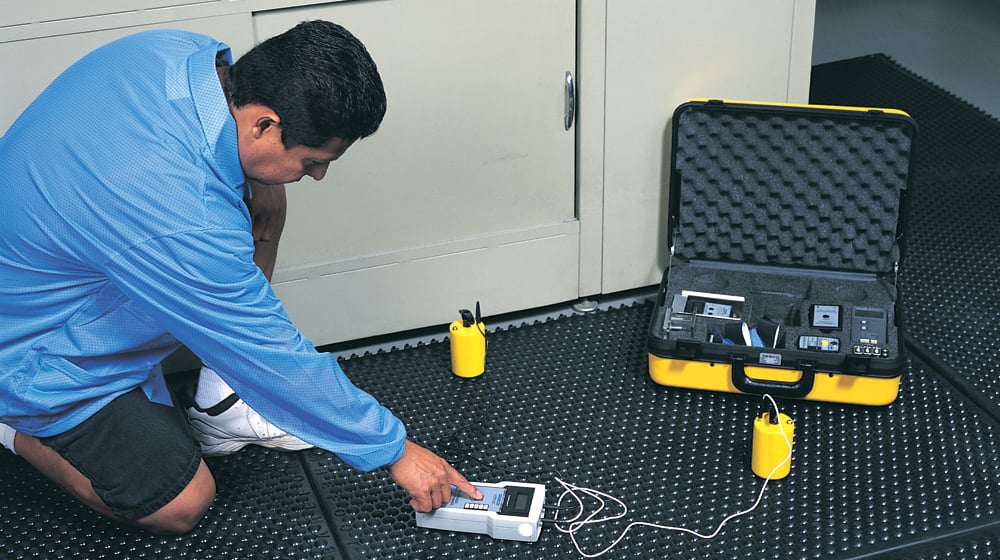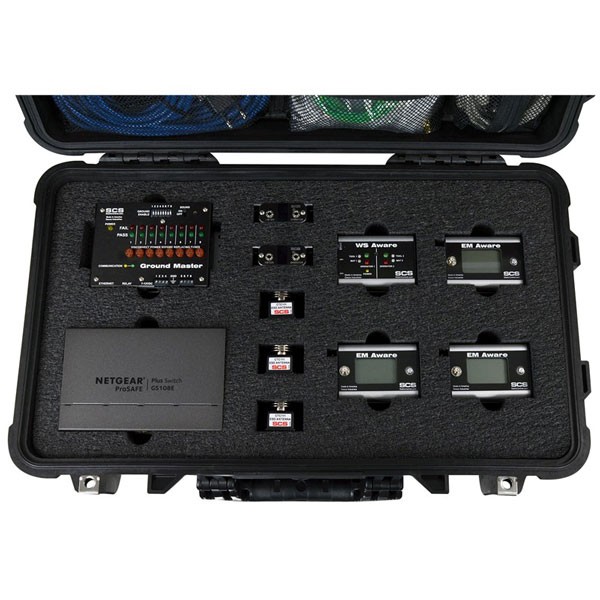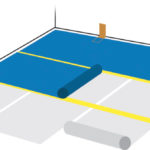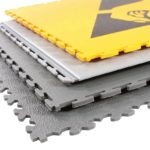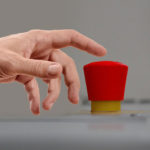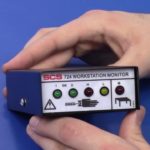Why would an ESD floor measuring approximately 5 meg-ohms generate over 300 volts of body voltage during a walking test? Despite ESD footwear and favorable conditions, this floor does not meet ISO quality standards in an electronics servicing facility. Damage may occur to sensitive electronic components by charges as low as 20 volts.
How Does a Floor Pass Resistance Test but Fail Body Voltage Tests?
Prior to 2014 S20.20 revisions, a resistance test below 1.0 x 107 easily complied with the resistive requirements. A ‘qualified’ ESD floor did not require body voltage generation tests.
The walking test requires connecting a test subject to a voltage-measuring device such as a charge plate monitor connected to a data collection device. The equipment determines if a person wearing specific types of static-control footwear will maintain a static charge maximum below 100 volts when walking on a static control floor.
As long as the floor measured less than 1.0 X 109 ohms, per ANSI/ESD STM 7.1, and provided system resistance of less than 3.5 x 107 ohms, per ANSI/ESD STM 97.1, it was assumed that the floor met the ≤ 100 volts threshold for charge generation.
There are multiple reasons for why a floor could pass resistive test criteria and still produce excessive (>100 volts) walking body voltage.
ESD Flooring Theory
An ESD Flooring system serves as a conduit for an electrical static charge to a controlled ground point.
ESD Carpet Tiles
ShadowFX™ is ideal for mission-critical, enduser environments – such as networked offices, call and dispatch centers, flight towers, and control rooms – that need to provide controlled dissipation and avoid liability exposure. It also out-performs many hard-surface options like ESD epoxy and ESD vinyl for ANSI/ESD S20.20 ESD-Protected Areas (EPAs) in the electronics industry.
The design theory behind an ESD floor is that static charge naturally flows from the less conductive topcoat to the highly conductive mid-layer. Conductive materials have low electrical resistance, and thus allow static charges to flow easily across its surface. Triboelectric charges generated by moving feet dissipate quickly through a grounded surface which is slightly conductive but not overtly.
Footwear is a common variable when assessing ESD flooring compliance. A standard shoe, even on a ESD floor, may generate upwards of 4,000 volts. Even certain types of ESD footwear generate substantial static charges, despite highly conductive floors with additives, matrices, and insulative base materials. Conductive shoes and ESD heel straps improve the efficacy of an ESD flooring system but are not appropriate in some environments. Grounded footwear is not feasible for command centers, computer labs, 9-1-1 call centers, and flight towers.
Mission-critical environments such as networked offices, call and dispatch centers, flight towers, and control rooms often opt for rubber ESD carpet tiles. It generally out-performs many hard-surface options like ESD epoxy and ESD vinyl for ANSI/ESD S20.20 ESD-Protected Areas (EPAs) in the electronics industry.
What Causes Misleading ESD Flooring Test Results?
Ohmmeter Principles
What enables a semi-conductive surface to appear conductive during a resistance test? Ohmmeters measure resistance by applying a DC current to a surface, floor, or material. The combined voltage and current enables the output voltage from the ohmmeter to punch through the topcoat to the conductive primer layer.
Misleading results occur most frequently with multi-layered epoxy flooring designs. An otherwise insulative top layer may still measure as a conductive composite material in response to the highly conductive middle layer below. In other cases, the floor was qualified in conjunction with ESD shoes but not the heel straps. Or, previous test results did not reflect current footwear choices. Most ESD coated floors will incur wear and eventually require replacement.
Since 2014, S20.20 requires body voltage generation testing for qualified ESD flooring. The walking test requires connecting a test subject to a voltage-measuring device such as a charge plate monitor. The voltage-measuring required connection to a separate data collection device. The equipment determines if a person wearing specific types of static-control footwear will maintain a static charge maximum below 100 volts when walking on a static control floor.
SMP Diagnostic Kits for Static Control Flooring Evaluation
ESD testing and monitoring equipment bought as individual components require a substantial capital investment. Complete static control diagnostic kits provide convenience, cost savings, and technical support from a single point of contact. The latest bundles include test equipment for body voltage, point-to-point, path-to-ground, continuous monitors, and LAN connection.
Monitoring capability includes the path-to-ground integrity and body voltage of two operators continuously, as well as the path-to-ground integrity for two conductive or dissipative worksurfaces and two metal tools. Every component fits neatly in a durable travel case for mobile-ready storage and safe transport.
- SMP Software License: Measures resistance point-to-point (Rtt) or surface to ground (Rtg)
- Ground Master Monitor: Continuously monitors the path-to-ground impedance and electromagnetic integrity of eight metal ground connections
- WS Aware Monitor: Continuously monitors the path-to-ground integrity and body voltage of two operators
- EM Aware Monitors: Continuously monitors ESD events, change in static voltage field, and ionizer performance
- 8-Port Ethernet Switch and (6) CAT5E Cables: Connects all included continuous monitors to a local area network (LAN)
- Pelican 1510 Carry-On Case with Lid Organizer and Foam Insert: Protects and stores test equipment; meets carry-on luggage size restrictions
- NIST Calibrated with Certificate: Calibrated with accepted procedures and standards traceable to the National Institute of Standards and Technology
Related Posts
-
Self-Install ESD Flooring Kits
Over time, an ESD floor will incur wear and eventually require replacement. A contractor will likely recommend that the entire floor is replaced. But is there a better way?
-
Static Control Flooring, ESD Epoxy, and Anti Static Primer. How It's Used and Where to Buy It
Static Free Flooring, ESD Tile, and ESD Coatings Updated 9/27/17 As static-sensitive electronic components grow more intricate, so do consumers of static-control flooring. Here are some key points to consider when choosing flooring for home…
-
Is Alpha Ionization Safe?
Radioactive Static Eliminators - Alpha Ionizers An alpha ionizer produces alpha particles which eliminate static electricity during sensitive manufacturing or electronics fabrication processes. The radioactive source (Po-210) in the Alpha Ionizer is encapsulated inside a…
-
Frequently Asked Questions about Alpha Ionization: Operation, Cleaning, Repair, and More
PAC is an authorized distributor of NRD Static Control and Ionization products. We've reposted this information from the NRD knowledge-base to better serve our customers. NRD Alpha ionizer vs AC ionizer - What's best for…
-
What Are the Differences Between Corona and Alpha Ionization?
This post covers the different types of static control ionization equipment and technologies. Which is best for your application?
-
Do You Need an ESD Chair if You Have an ESD Floormat?
An ESD chair is recommended even when an ESD floor or floormat is in use. The user removing their feet from the floor could cause static generation and discharge. A combination of ESD flooring and…
-
Staticworx ESD Flooring Installation Guide
In this guide, you’ll learn about various installation methods, find detailed instructions, and also learn where you can buy the materials you’ll need for installation at your facility. The type of installation you choose requires…
-
Self-Install ESD Flooring Kits
Over time, an ESD floor will incur wear and eventually require replacement. A contractor will likely recommend that the entire floor is replaced. But is there a better way?
-
Is Linoleum Flooring Conductive or Anti-Static?
Genuine linoleum is a 100% biodegradable material composed of linseed oil, pine resin, cork, wood, pigment, and limestone. Depending on material construction, it is known to have antistatic properties which mitigate some triboelectric charges that…
-
What Is Conductive Flooring? How Is It Different from Anti-Static?
Definition of Conductive Flooring ANSI/ESD S20.20 flooring specifications, see here. Moving feet and contact with objects generate triboelectric charges. Static sensitive areas require a grounded flooring surface which is slightly conductive but not overtly. ANSI Defines…
-
Static Control Flooring, ESD Epoxy, and Anti Static Primer. How It's Used and Where to Buy It
Static Free Flooring, ESD Tile, and ESD Coatings Updated 9/27/17 As static-sensitive electronic components grow more intricate, so do consumers of static-control flooring. Here are some key points to consider when choosing flooring for home…
-
What Is the Differences Between Dual Wire and Single Wrist Straps?
Reposted from Our Vendor SCS-Static-Control Solutions Dual wire ESD monitors and ESD wrist straps are the most common personnel grounding device to ground operators. In today’s blog post, we will talk about the difference between dual-wire…
-
Air Ionization for Particulate & Contamination Control PDF from Simco-Ion
Our friends at Simco-Ion sent us this brilliant guide to ESD cleanrooms design, principles, and other considerations. Download the PDF you’ll find case studies and technical information about how static charges influence particle retention and…
-
ESDS Device Sensitivity and Testing: The Fundamentals of Electrostatic Discharge, Part 5
This copyrighted information is licensed for reproduction by EOS/ESD Association, Inc. Click here to view the original article. In Part Two of this series ("Principles of ESD Control – ESD Control Program Development"), we indicated that a…
-
Proper Material for ESD Cleanroom Gloves
ESD cleanroom glove materials have reduced NVR (non-volatile residues) levels for better electrical conductivity. Meanwhile, dedicated ESD fabrics are often not viable for cleanroom use, as they tend to shed particulates at a much higher…

